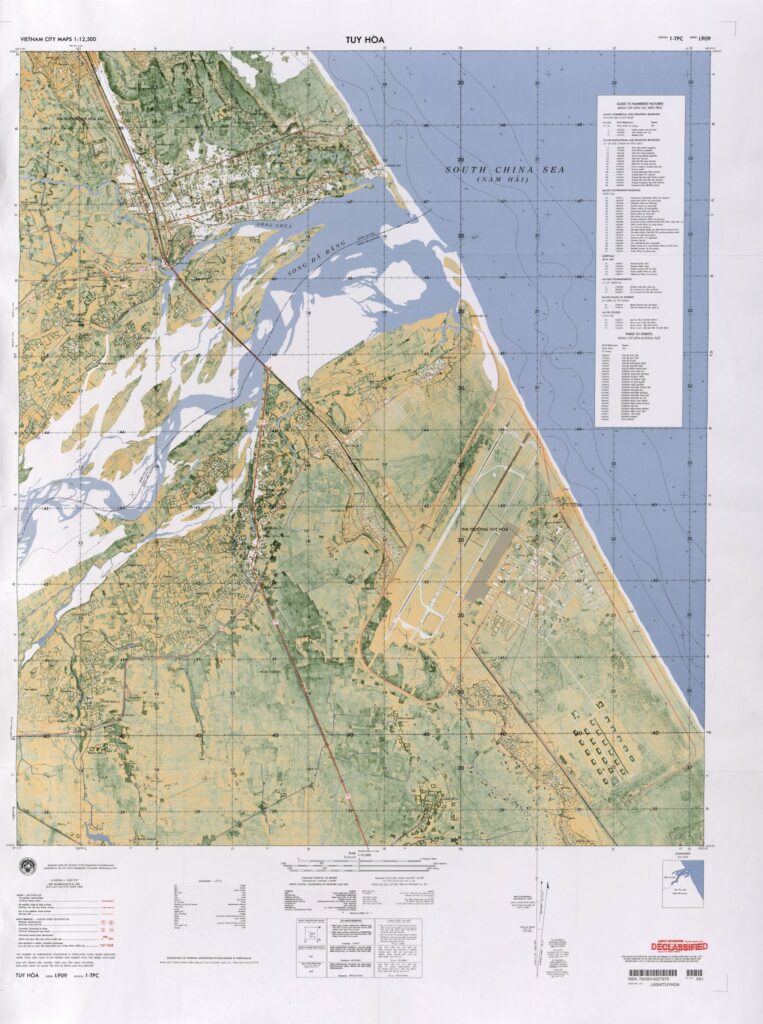ARRIVAL – TUY HOA – A SEASON OF FIRSTS
As the Gordon pulled into port in Nha Trang on Wednesday, October 5th, the men aboard began to get their first glimpse of the lush green landscape that would be their battleground. Quickly moved off the ship, they experienced their first convoy of the war, and were trucked north to the small coastal town of Tuy Hoa. Here, the 1st Brigade of the 4th Infantry Division established its headquarters, at the Tuy Hoa Base Camp and its adjacent Phu Hiep Army Airfield. Life alongside the beaches of the South China Sea had its perks, and Braves of 3-12 quickly settled in to their new normal. Daily patrols by armored M-113 tracked vehicles driven by the men of A Troop, 1-10 Cavalry, and occasional helicopter insertions into areas further out in the countryside near Tuy Hoa.
On October 25, 1966, the 1st Brigade, 4th ID initiated Operation Adams alongside 1st Brigade, 101st Airborne and the 47th Regiment of the Army of the Republic of Vietnam. Operation Adams was aimed at protecting the locals as the began their annual rice harvest, as well as search and destroy operations aimed and suspected Viet Cong installations.
The end of October and first week of November found the men of the Braves getting accustomed to patrolling, both in the rice paddies and the surrounding jungle hillsides. The battalion was ordered to conduct search and destroy operations west of Tuy Hoa and acting as a blocking force for the 101st Airborne elements maneuvering west of the Operation Adams operations area. Contact was light, but it didn’t take long for the odd angry shot of combat to claim its first victim.
On the 4th of November, 1966, Charlie Company was patrolling in the area near Tuy Hoa, and PFC Denny Bruce, a 20-year old drafted infantryman from Aurelia, Iowa walked as the point-man for his unit, tasked with keeping them on course and sniffing out the dangers that may lay ahead. War was still new to most of them, and even the most skilled point-man only had a few weeks of experience. As the patrol moved through the jungle, PFC Bruce spotted an armed Viet Cong soldier, and spun around to give a warning to the men behind. The VC didn’t give him a second chance, and PFC Bruce was struck down in a burst a gunfire. The platoon medic, Bob Terlisner, raced to his side and began first aid, but even as he bandaged the wound he could tell it was fatal. Back home in Iowa, Clifford and Florence Bruce had no idea that their world was about to be turned upside down, and they would be the first parents of a Brave of the 3-12 to be asked to bear the burden of losing a son in Vietnam.
As word spread around the battalion that Charlie Company had lost a man, there was no denying that the next 10 months of their lives would be no picnic, and that casualties were sure to keep coming. The threat of the Viet Cong and the North Vietnamese Army was out there, but in every war, death and injury are often caused not by the enemy, but by the inherent danger that exists in the business of war. Helicopters crash, soldiers drown and fratricide occurs.
On November 15th, the battalion was air assaulted into the high ground about 5 kilometres northeast of Dong Tre Special Forces Camp. This high ground, consisting of approximately 80 square kilometers of relatively low hills and jungle plateaus, with the highest point being marked at just 382 meters above sea level. The battalion split into company sized elements and began patrolling generally east, through the Song Cai River valley and back towards the village of Tuy An on the South China Sea.
On December 21st, Alpha Company, commanded by Captain Christensen, finished the daily movement and began establishing a night defensive perimeter. PFC Richard Keith Finsterwalder and other men from A Co settled in, setting out claymore mines, digging foxholes and laying out grenades and ammunition for the night ahead. As dawn broke on the 22nd, the men of 1st Platoon gathered up their claymores and secured their grenades from the night before. Suddenly, one of Finsterwalder’s grenades exploded and sent jagged splinters of shrapnel into the 21-year old from Carthage, New York A 1963 graduate of Carthage Central High School in Carthage, New York, Finsterwalder had been working summers at the Tree Sweet Processing Company in Santa Ana, California, and studying at the I.B.M school in Syracuse, New York when he was drafted. He entered the U.S. Army at Fort Dix, New Jersey in December of 1965 and was shipped to Ft. Lewis, Washington for training as a mortarman in the 11C Military Occupation Specialty. In February of 1966, he was married to Miss Barbara Everard. 1LT Nichols, the platoon leader of Alpha Company’s 1st Platoon, was from the Tacoma area, and graciously gave up his house for the young soldier and his wife to hold a wedding party. Now, just ten months into her marriage, Mrs. Barbara Finsterwalder became the first widow of a 3-12 Infantry Soldier. She would not be the last.

Sources :
https://www.vvmf.org/Wall-of-Faces/6361/DENNY-L-BRUCE
https://www.vvmf.org/Wall-of-Faces/16187/RICHARD-K-FINSTERWALDER
Operational Report Lessons Learned – 1st Bde, 4th ID, Reporting Period ending Jan 31,1967.
https://apps.dtic.mil/dtic/tr/fulltext/u2/388158.pdf
http://coastdaylight.com/scph/scph_orange_sa.html

